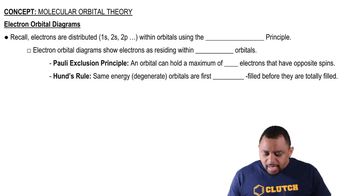Here are the essential concepts you must grasp in order to answer the question correctly.
Electron Configuration
Electron configuration describes the distribution of electrons in an atom's orbitals. It follows the Aufbau principle, which states that electrons fill lower-energy orbitals first. For sulfur, with an atomic number of 16, the ground state electron configuration is 1s² 2s² 2p⁶ 3s² 3p⁴. Understanding how to modify this configuration when electrons are lost to form cations is essential for determining the electron configurations of sulfur's cations.
Recommended video:
Electron Configuration Example
Cation Formation
Cation formation occurs when an atom loses one or more electrons, resulting in a positively charged ion. For sulfur, this process involves removing electrons from the outermost orbitals, specifically the 3s and 3p orbitals. The number of electrons lost determines the charge of the cation, with sulfur capable of forming cations with charges ranging from +1 to +6. This concept is crucial for understanding the electron configurations of the resulting cations.
Recommended video:
Orbital Diagrams
Orbital diagrams visually represent the arrangement of electrons in an atom's orbitals, using arrows to indicate electron spins. Each orbital can hold a maximum of two electrons with opposite spins, and unpaired electrons are shown as single arrows. For cations with unpaired electrons, these diagrams help illustrate the electron distribution after ionization. Understanding how to construct these diagrams is important for analyzing the electronic structure of sulfur's cations.
Recommended video:
Electron Orbital Diagrams

 Verified step by step guidance
Verified step by step guidance

